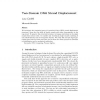Free Online Productivity Tools
i2Speak
i2Symbol
i2OCR
iTex2Img
iWeb2Print
iWeb2Shot
i2Type
iPdf2Split
iPdf2Merge
i2Bopomofo
i2Arabic
i2Style
i2Image
i2PDF
iLatex2Rtf
Sci2ools
CORR
2010
Springer
2010
Springer
Two-Domain DNA Strand Displacement
We investigate the computing power of a restricted class of DNA strand displacement structures: those that are made of double strands with nicks (interruptions) in the top strand. To preserve this structural invariant, we impose restrictions on the single strands they interact with: we consider only two-domain single strands consisting of one toehold domain and one recognition domain. We study fork and join signal processing gates based on these structures, and we show that these systems are amenable to formalization and to mechanical verication.
CORR 2010 | Education | Single Strands | Strand Displacement Structures | Two-domain Single Strands |
| Added | 09 Dec 2010 |
| Updated | 09 Dec 2010 |
| Type | Journal |
| Year | 2010 |
| Where | CORR |
| Authors | Luca Cardelli |
Comments (0)

